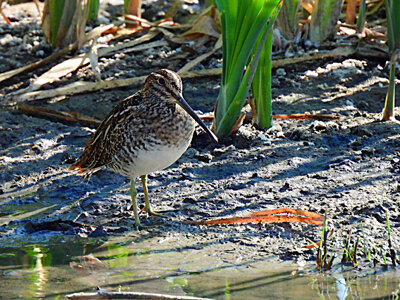
Photo courtesy Charles Martinez
This week’s Bird of the Week, compliments of the Weminuche Audubon Society and Audubon Rockies, is the Wilson’s snipe.
Camouflage is the name of the game for this member of the sandpiper family. Patterned in buff- and brown-colored stripes and bars, this bird easily disappears into its surrounding wetland habitats. A medium-sized shorebird with a rounded head, it can appear nearly neckless and its long, straight bill is several times the length of its head.
Extra large pectoral muscles which make up one quarter of the bird’s total weight give it a stocky look and allow for fast, strong flight at speeds up to 60 miles per hour. It is one of the most abundant and widespread shorebirds in North America, with most breeding throughout Canada and the northern United States. Our area is within the year-round range, but migratory populations winter farther south, with some traveling as far as South America.
All types of wet, marshy areas with sedges, rushes and cattails, and flooded cultivated fields provide foraging opportunities for the snipe. It feeds by burying its bill into soft, wet soil where sensitive endings help to locate food. Flexible bill tips allow it to capture and eat prey in the mud while its bill is still buried. Insect larvae, worms and small invertebrates are the primary food source but on occasion it will take larger prey like lizards, frogs, fish and even nestling birds.
With eyes set far back on its head, the Wilson’s snipe can almost see in all directions without moving. When startled, it will flush abruptly and take to the air in zigzag flight while uttering a raspy call. This is the only vocalization made by these birds outside of breeding season, when they are also known for the loud humming sound produced by airflow over outstretched tail feathers during territorial and courtship flights.
Visit one of our shallow water wetland areas to conduct a snipe hunt of your own to find these attractive birds.
For information on events, visit www.weminucheaudubon.org and www.facebook.com/weminucheaudubon/.